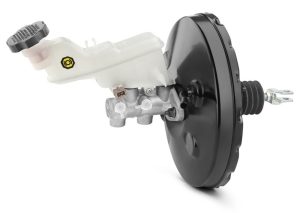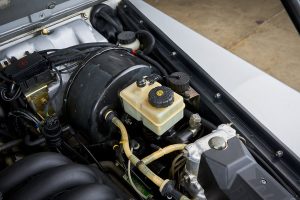When you press your car’s brake pedal, you expect a quick and effortless response. Behind this ease of braking lies a key component: the brake booster. This often-overlooked part of the braking system plays a vital role in amplifying the force from your foot to ensure effective stopping power. But not all brake boosters are the same—some operate using vacuum, while others rely on hydraulic pressure.
In this article, we’ll break down how brake boosters work, the differences between vacuum and hydraulic systems, and how to know when it’s time for a replacement.
What Is a Brake Booster?

A brake booster is a device located between the brake pedal and the master cylinder. Its job is to multiply the force you apply with your foot, making braking more efficient and less physically demanding.
Without a brake booster:
-
You’d need to apply much more force to the brake pedal.
-
Braking would feel stiff and unresponsive.
-
Stopping distances could increase in critical situations.
How Does a Brake Booster Work?
Brake boosters work by amplifying the input force from the driver and delivering it to the master cylinder. This is achieved through one of two methods:
1. Vacuum Brake Boosters (Most Common)
-
Use engine vacuum to create a pressure differential.
-
As you press the brake pedal, a valve opens, allowing outside air to enter one side of a diaphragm while the other side remains under vacuum.
-
The resulting pressure difference pushes the diaphragm, adding force to the master cylinder.
2. Hydraulic Brake Boosters (Used in heavy vehicles and ABS-equipped cars)
-
Use hydraulic pressure from the power steering pump instead of vacuum.
-
A control valve directs pressurized fluid into the booster when the brake pedal is pressed.
-
This pressure moves a piston that assists in pushing brake fluid through the master cylinder.
Vacuum vs. Hydraulic Brake Boosters: A Comparison
| Feature | Vacuum Brake Booster | Hydraulic Brake Booster |
|---|---|---|
| Power Source | Engine vacuum | Power steering pump (hydraulic fluid) |
| Usage | Most passenger cars | Larger trucks, SUVs, performance cars |
| Size | Larger and round (diaphragm-based) | Smaller and cylindrical (piston-based) |
| Booster Force | Moderate (based on vacuum strength) | High (based on fluid pressure) |
| Dependency | Vacuum from engine | Hydraulic pressure from steering pump |
| Best for | Fuel-efficient vehicles | Heavy-duty or performance vehicles |
| Cost | Lower | Higher |
How to Identify Your Brake Booster Type
Here’s a quick way to determine the kind of booster in your vehicle:
Vacuum Brake Booster Signs:
-
Usually mounted on the firewall behind the brake pedal.
-
Round, black canister shape.
-
Vacuum hose connected to the intake manifold.
Hydraulic Brake Booster Signs:
-
Found on some diesel engines and larger SUVs/trucks.
-
Connected to the power steering system.
-
More compact, with fluid lines and a hydraulic accumulator.
Signs of a Failing Brake Booster
A faulty brake booster can significantly reduce braking efficiency and compromise safety. Be alert to the following symptoms:
Common Warning Signs:
-
Hard brake pedal – feels like you have to stand on the pedal.
-
Longer stopping distance – the vehicle takes longer to stop.
-
Hissing noise – air leaking near the booster (for vacuum types).
-
Increased engine RPM – vacuum leak can disturb air/fuel mixture.
-
Brake warning light – in modern vehicles with electronic diagnostics.
Troubleshooting Tip:
To test a vacuum booster:
-
Turn off the engine and pump the brake pedal 3–5 times.
-
Then hold down the pedal and start the engine.
-
If the pedal sinks slightly, the booster is working. If not, it may be faulty.
When to Replace Your Brake Booster
Brake boosters typically last a long time, but they can fail due to:
-
Vacuum leaks
-
Diaphragm damage
-
Faulty check valves
-
Hydraulic pressure loss
Replacement Interval:
There’s no fixed mileage, but brake boosters usually last between 150,000–250,000 km depending on usage and system type.
Brake Booster Components Overview
| Component | Function |
|---|---|
| Diaphragm (vacuum) | Creates pressure differential for assistance |
| Check valve | Maintains vacuum when engine is off |
| Hydraulic piston | Transfers fluid pressure in hydraulic systems |
| Accumulator | Stores pressurized fluid for emergency use |
Brake Boosters in Modern Cars
Modern vehicles often combine brake boosters with ABS (Anti-lock Braking Systems) and ESC (Electronic Stability Control) systems. Some even use electric brake boosters, especially in EVs (Electric Vehicles), which lack an engine vacuum source.
Replacing Your Brake Booster

If your booster fails, it should be replaced promptly to avoid unsafe driving conditions. You may also need to replace:
-
Brake fluid (bleed system)
-
Master cylinder (if damaged)
-
Vacuum hose or check valve
Buy Brake Booster online for reliable, high-quality replacements compatible with your vehicle model.
Final Thoughts
The brake booster is a silent helper, ensuring that your light pedal input results in powerful stopping force. Understanding the difference between vacuum and hydraulic systems helps you recognize problems early and choose the right part when it’s time to replace.
By keeping your brake booster in top condition, you’re not just improving braking — you’re protecting everyone on the road.